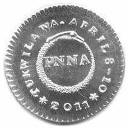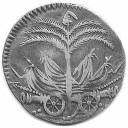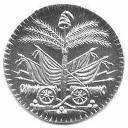 The PNNA Memorabilia Catalog
The PNNA Memorabilia Catalog
2011 Convention - Index | Return to catalog pageClick on the thumbnail images for a larger version. | Copyright information.
THE 2011 PNNA CONVENTION SOUVENIR COMMEMORATIVE
by Greg Franck-Weiby




Left to right:
Model coin - Republique d'Hayti 12 centimes, year XI (1814),
snake design / 2011 PNNA token version.
Model coin - palm tree arms on a 25 centimes of year 10 (1813) / 2011 PNNA token version.
Explanatory text:
The souvenir/commemorative medalet for the 62nd PNNA convention reflects the turmoil we see around us at present, representing revolutionary struggles for freedom, with all its hopes and dangers, as well as geological upheavals. The model coins are the first type struck in the name of the Republic of Haïti (although it was actually spelled ‘Hayti’ on the coins) – the first republic established by a successful slave revolt (and punished for it by the former slave owning powers ever since). One side bears the design that has been the national coat of arms, used on most Haïtian coins since then, a palm tree with cannons, pike staffs, musket muzzles with fixed bayonets, and battle flags, with a Liberty cap in the top of the tree. The other side has an image unique in coin design – an ‘ouroboros,’ i.e. a snake holding its tail in its mouth. In many ancient religions, snakes symbolized the cycle of death and rebirth because they shed their skin. Because they were associated with rival religions, the Judaeo-Christian-Islamic tradition has regarded snakes as symbols of evil. Consequently, a snake biting its tail is likely to be interpreted as symbolizing evil consuming itself. To the West African ancestors of most Haitians, it meant something completely different. In West African creation stories, all of the elements of the cosmos are held together in the coils of a great snake. The snake grips its tail in its mouth to prevent loosening its coils. If the snake ever lets go of its tail, the world will dissolve in chaos. The snake design was only used on 1813-1815 Haitian coins (although the coins were actually dated in revolutionary years, counting from the end of the Haitian war of Independence in 1803 – year 10 [inclusive] = 1813).
The Haitian monetary system was the ‘gourde,’ a silver coin about the size of a half dollar (and apparently unrelated to any other contemporary monetary system), divided into 100 centimes. The denominations of the snake type series were 25 centimes, 12 centimes (approximately 1/8 gourde) and a tiny 6 centimes (~1/16 gourde). The PNNA medalet is closest in size to the 12 centimes. The original coins’ dies were all hand cut with a great range of variability.